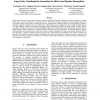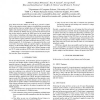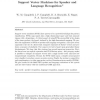47 search results - page 3 / 10 » The Use of Group Delay Features of Linear Prediction Model f... |
ICASSP
2009
IEEE
14 years 2 months ago
2009
IEEE
Maximum-Likelihod Linear Regression (MLLR) transform coefficients have shown to be useful features for text-independent speaker recognition systems. These use MLLR coefficients ...
LREC
2008
13 years 9 months ago
2008
Recent years have seen increased interest within the speaker recognition community in high-level features including, for example, lexical choice, idiomatic expressions or syntacti...
ICASSP
2011
IEEE
12 years 11 months ago
2011
IEEE
Deep Belief Networks (DBNs) are multi-layer generative models. They can be trained to model windows of coefficients extracted from speech and they discover multiple layers of fea...
AVBPA
2003
Springer
14 years 29 days ago
2003
Springer
Abstract. Weighted distance measure and discriminative training are two different approaches to enhance VQ-based solutions for speaker identification. To account for varying import...
CSL
2006
Springer
13 years 7 months ago
2006
Springer
Support vector machines (SVMs) have proven to be a powerful technique for pattern classification. SVMs map inputs into a high dimensional space and then separate classes with a hy...



